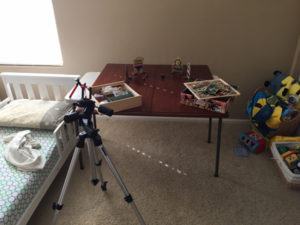My Walking Dead miniatures game didn’t arrive this week so I decided to take a break from some of my ongoing projects and focus on a little side project I’ve been wanting to wrap up. I’ve been fascinated with slow motion option on my iPhone for a while now and after messing around with Pretzel Games‘ Flick ’em Up!, I found a great subject to try out this feature.
Initially, I tried out a little sample video but quickly realized I had a big issue: light flicker.
After doing some research, I thought I found a solution in some battery-operated LED lights but they weren’t bright enough. The video was ok and I could hide some of the issues by putting a few filters on like digital scratching and stripping the color out (which was awful looking anyway in the heavy blue tint of the LEDs) but it still wasn’t achieving what I wanted.
I let the project sit for a bit as I wasn’t ready to invest a heavy amount of cash for professional lighting to remove the flicker. The ultimate solution was actually pretty obvious when I thought about it. The reason for the flicker is the use of lights based on the alternating current of your house’s electricity and the frame rate being fast enough to catch the light alternating from the lighted to non-lighted state. Using direct current options will remove the flicker issue but I already tried that with the battery-operated LEDs. There is an obvious alternative light source that will also not have flicker issues: the Sun.
Direct sunlight is easy enough but the resulting images are pretty harsh. I don’t really have any opaque screens to soften this light but while walking through my house, I noticed that one of my kids’ rooms had some great ambient light. With this, I did some creative rearrangement to set up my “studio” and was able to shoot a bunch of slow motion shots of Flick ’em Up!
I ended up shooting over a hundred takes and then cut them down to about 35 usable clips. IPhone’s slow motion feature is a little odd in that it records the footage in 240 fps (frames per second) but keeps the actual video time the same as the recording time. The iPhone is smart enough to understand this and play the footage in a normal 30 fps but if you export the video, most devices will adhere to the timecode of the clip and not change the fps, meaning you’ll lose the slow motion effect as the system tries to play the video back at 240 fps.
The work around for this issue is to export the clip into iMovie (free app) and then export the clip back again to your photos folder. This converts the clip to the appropriate 30 fps and slow motion effect. I then used Lightworks (free video editing software) to put all the clips together and added some great Ennio Morricone music for effect.
I’m pretty satisfied with the result and it was a lot of fun to get back into video editing again.

